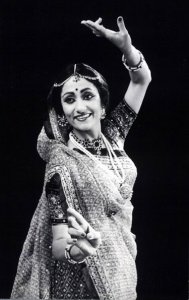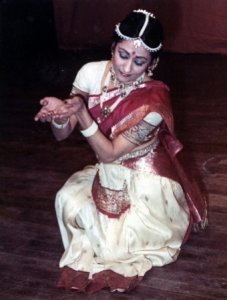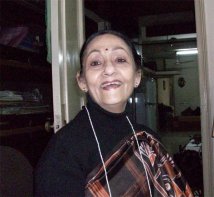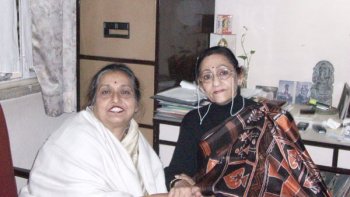
|
 |

|
 |
Kathak guru Rani Karnaa's journey of life and dance - Nita Vidyarthi, Kolkata e-mail: nitavidyarthi@gmail.com July 3, 2011  Seemingly endless in the fertility of her imaginative choreographic and literary resources, Sangeet Natak Akademi awardee Rani Karnaaa, the outstanding Kathak guru, has been enriching the dance form, resourcefully drawing from her treasure-trove of training under great gurus, integrating the traditions of Jaipur and Lucknow gharanas. Born in Hyderabad, Sindh, this very learned dancer and outstanding teacher has made Kolkata her home. The seventy one year old Guru, who lives for her dance and her students, who love and respect her immensely, managed time to answer some questions. You are from Sindh.. I came to Delhi with my parents from Sindh when I was three / four years old. My home town was Larcana. What was it about Kathak that struck you because you did Odissi too? You know it well that Kathak is from the North and that was one of the prevalent dance forms at that time when I was a girl of five. At Connaught Place in Delhi near Regal theatre, my uncle had a shop and I used to take a long walk from home till there as a routine. On the way, I passed the institution where I heard jingle bells, the 'ghungroo' which attracted me. Here Kathak was taught and so I joined the institution to learn. As a child, I also did Bharatanatyam and Manipuri, but I chose to specialize in Kathak. One reason for this was the language - Brijbhasa and Khariboli. I was comfortable with Hindi so I was also comfortable in learning Kathak - the poems, kavits etc and I was doing well. I was doing well in Bharatanatyam too. I learnt Odissi much later. I was married into an Oriya family and after my marriage in 1963, I came across Kumkum Mohanty who was a distant relative of mine - I was her bhabhi. I asked her if she could seek permission from Guru Kelucharan Mohapatra to teach me. He readily agreed and said, "Of course, she is a deserving student." As a dancer I was known in college and in Delhi University. You learnt Odissi and came back to Kathak again. One - I did not leave Kathak for Odissi. Two - I used to dance both the dance forms. That must have been difficult! Yes, it is difficult but there is always a challenge. Since I have done Bharatanatyam and Manipuri, it was a kind of comparative study. That was the idea, to understand Odissi also for the sake of it. It was very alluring to me. It has its own individual grace, both posture wise, angular grace and straight and lyrical grace. It was not like Bharatanatyam or Kathak and that was the challenge - to keep each dance style defined without mixing them up while dancing Kathak. I found it needed to be practised a lot. The bhanghimas, tribhangas, chaukas all needed a lot of practice. Even learning was very demanding but interesting as I could understand, speak Oriya even the songs Guruji taught and fortunately as I was into yoga and dancing, I had the suppleness of body that was needed for this dance form. Since I was performing both, the audience expected me to present both the forms, and I had to fulfill their desires. That was more difficult - to simultaneously perform both movements. I had very good opportunities and performed Odissi in a number of towns here as well as in Belgium and Luxemburg and had positive response.  Why did you leave Odissi and devote full time to Kathak? No! No! I didn't plan to leave Odissi, I got left out. With a family, I found it difficult to devote the time Odissi demanded, and since I learnt Kathak from childhood that was comfortable for me. Also, Guruji was not always available for pakhawaj accompaniment for performances and used to send his son Ratikanta and also Giridhari Nayak at times and the Odissi team was not available in Calcutta. It was expensive to get musicians from Orissa! As early as 1967, I performed in Delhi and Guruji and Rakhal Mohanty came and sitar and flute accompaniments were hired from Delhi. They stayed with us in my mother's place; my mother cooked for them and Guruji was very fond of the food cooked by her! The whole paraphernalia of arranging for musicians and rehearsing with them at that time in Calcutta when Odissi was not so common was difficult. Besides, I had to have time for my riyaz, my performances and my teaching also. There is an atmosphere of Kathak here and I had top notch tabla players like Ramesh Mishra, his father Ramnathji, Sabir Khan and Swapnomoy Banerjee for sarod and a couple of good sitarists like Chandrachur. I started teaching at the Calcutta School of Music. And now I have my team of musicians for my academy Samskritiki Shreyaskar like Anjan Saha, Subhashish Bhattacharya, Siddharth Bhattacharya, Naresh Mukherjee and for vocal I have different artistes who have been trained. What special methods have you adapted to make yourself a marvellous teacher and an exclusive dancer? (Laughs loudly)! I think the journey of life and dance. It comes your way, the plan, the hard work, something is destined and something you really have to chalk out in a diligent manner, otherwise it does not work. Work, work and work! (Laughs again). Calcuttans and Bengalees are music and dance lovers and accept non-Calcuttans as lovingly and warmly as their own and it is the ambience, the environment of dance that surrounds you which mattered. Is that the reason that you made Calcutta your home? Yes, more so because my husband was posted here and I had to shift from Delhi. I have been here from '78 regularly, even after all personal tragedies. How do you prepare yourself, primarily your body, i.e. warm up for a) riyaz b) then for your production c) the special attention you give to your text which are immensely rich and intellectual? (Laughs loudly again) First let me tell you about my body. Basically, I have been fortunate by the grace of God and have always been light on my feet as my mother used to say, had exposure to yoga and asanas and have learnt yoga from different swamis, Hathayoga also. Yoga and asanas, especially ashtanga yoga, should be a subject for all dancers. But then there is a constraint of time for the learners. I conduct such workshops during vacations, but you can't (even for dancing) achieve much for once a week dance classes. So students should learn yoga on their own. You were talking about my production 'Surya, the Sun God.' When I was preparing for that particular production, I did call a yoga teacher and made them do a set of asanas especially 'Surya namaskar.' So that is the exercise part. Blood circulation is rejuvenation- battery charge. Do not succumb to age related problems. I combine all this with other things like Reiki, self healing touch, Vipasana, sound and colour therapy. I do Reiki when I am extremely tired and then exercise, do shavasana, pranayama. Joints have to be taken care of. Since I am dancing, I have to manage with pranayama and asanas. I do not need rigorous exercise.  Rani Karnaa  Nita Vidyarthi, Rani Karnaa What according to you should be the basic qualities of a good dancer? Stamina for dance, then exposure, training, understanding, basic educational qualifications, then sustained rehearsals so that the training can be manageable smoothly. Then follow a certain basic syllabi and performing capacity and then your awareness for body and needs and a good understanding of tala and bhava. This does not come easily -it takes time. And the dancer must have an individualistic quality of her own to carry herself well. Don't you think they must have knowledge of music too? It is a must. There are 10 virtues of a dancer and one is voice training. As far as text is concerned, I have an immense craving for knowledge "Khojney ka tamanna" and always feel an incompleteness as far as knowledge is concerned - "adhurapan" and I keep on hunting for this "jivansaar." I already have a list of productions in my mind, like a sequel of Surya and his family - the solar system. Till now, I have only spent long periods on Gayatri! You have worked with children to stage wonderful productions like Tagore's poem 'Saad.' Do you have special methods for them? No special methods as such! I have given them "latitudes and longitudes." I let them love dance and dance in relaxation. Where do you get your strength from? From self, self! From my gurus and also got strength from my husband who was a good critic of mine. I believe in Vishwapita and "Nirakar Param Brahma." Any regrets? No, No! I am at peace. I tell my students, any award or not, I shall die in peace. Ratio-wise, the quantity and quantum of work happening around does not bother me. I believe in good quality of work. If I give quantity, I cannot give quality. Whatever work I have done, I have always searched for quality. I do not teach a crowd. I have a limited number of students and to them I give my best. Contact: ranikarnaa@gmail.com website: ranikathak.com Post your comments Please provide your name and email id when you use the Anonymous/blog profile to post a comment. All appropriate comments posted with name & email id in the blog will also be featured in the site. |